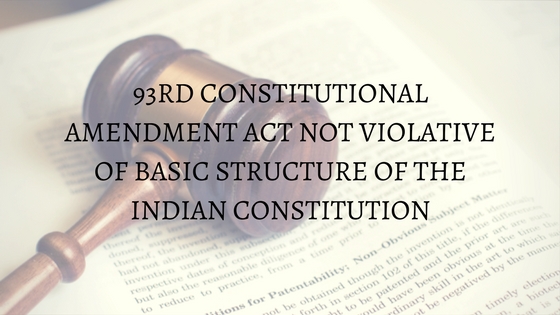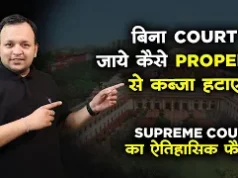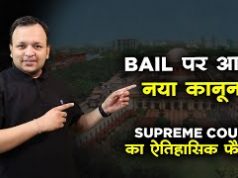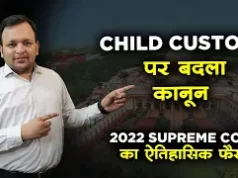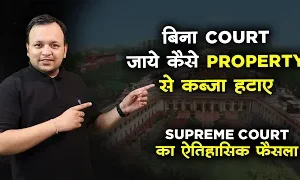Aapka Consultant Judgment Series- In this series, we are providing case analysis of Landmark Judgments of Hon’ble Supreme Court of India.
Ashoka Kumar Thakur Vs. Union of India (UOI) and Ors.
2008 (5) SCALE 1, (2008) 6 SCC 1
Hon’ble Judges/Coram : K.G. Balakrishnan, C.J., Dr. Arijit Pasayat, C.K. Thakker, Dalveer Bhandari and R.V. Raveendran, JJ.
Date of Decision: 10.04.2008
FACTS: –
The Parliament introduced Article 15(5) by The Constitution (Ninety-Third Amendment) Act, 2005 to enable the State to make such provision for the advancement of SC, ST and Socially and Educationally Backward Classes (SEBC) of citizens in relation to a specific subject, namely, admission to educational institutions including private educational institutions whether aided or unaided by the State notwithstanding the provisions of Article 19(1)(g). After the above Constitution (Ninety-Third Amendment) Act, 2005, the Parliament passed The Central Educational Institutions (Reservation in Admission) Act, 2006 (hereinafter referred to as “the Act 5 of 2007”). The same is challenged in various petitions, on various grounds.
ISSUES: –
- Whether Ninety-Third Amendment of the Constitution is against the “basic structure” of the Constitution?
- Whether Articles 15(4) and 15(5) are mutually contradictory; hence Article 15(5) is to be held ultra vires?
III. Whether exclusion of minority educational institutions from Article 15(5) is violative of Article 14 of Constitution?
- Whether the Act 5 of 2007 is constitutionally invalid in view of definition of “Backward Class” and whether the identification of such “Backward Class” based on “caste” is constitutionally valid?
- Whether Creamy Layer is to be excluded from SEBCs?
- Whether the “creamy layer” principle is applicable to Scheduled Tribes and Scheduled Castes?
JUDGMENT: –
The Constitution (Ninety-Third Amendment) Act, 2005, by which Clause (5) was added to Article 15 of the Constitution, is an enabling provision which states that nothing in Article 15 or in Sub-clause (g) of Clause (1) of Article 19 shall prevent the State from making any special provision, by law, for the advancement of any socially and educationally backward classes of citizens or for the Scheduled Castes or the Scheduled Tribes in so far as such special provisions relate to their admission to the educational institutions including private educational institutions, whether aided or unaided by the State. Of course, minority educational institutions referred to in Clause (1) of Article 30 are excluded. Thus, the newly added Clause (5) of Article 15 is sought to be applied to educational institutions whether aided or unaided. Act 5 of 2007 has been enacted to provide reservation of seats for Scheduled Castes, Scheduled Tribes and SEBCs of citizens in Central Educational Institutions. The “Central Educational Institution” has been defined under Section 2(d) of the Act. They are institutions established or incorporated by or under the Central Act or set up by an Act of Parliament or deemed Universities maintained by or receiving aid from the Central Government or institutions maintained by or receiving aid from the Central Government or educational institutions set up by the Central Government under the Societies Registration Act, 1860.
For determining whether a particular feature of the Constitution is part of the basic structure or not, it has to be examined in each individual case keeping in mind the scheme of the Constitution, its objects and purpose and the integrity of the Constitution as a fundamental instrument for the country’s governance. Constitutional amendments, if any challenge is made on the basis of basic structure, it has to be examined based on the basic features of the Constitution. It may be noticed that the majority in Kesavananda Bharati’s case did not hold that all facets of Article 14 or any of the fundamental rights would form part of the basic structure of the Constitution. The majority upheld the validity of the first part of Article 30(1)(c) which would show that the constitutional amendment which takes away or abridges the right to challenge the validity of an arbitrary law or violating a fundamental right under that Article would not destroy or damage the basic structure. Equality is a multi-coloured concept incapable of a single definition as is also the fundamental right under Article 19(1)(g). The principle of equality is a delicate, vulnerable and supremely precious concept for our society. It is true that it has embraced a critical and essential component of constitutional identity. The larger principles of equality as stated in Article 14, 15 and 16 may be understood as an element of the “basic structure” of the Constitution and may not be subject to amendment, although, these provisions, intended to configure these rights in a particular way, may be changed within the constraints of the broader principle. Therefore, The Ninety-Third Amendment to the Constitution does not violate the “basic structure” of the Constitution so far as it relates to aided educational institutions.
Both Article 15(4) and 15(5) are enabling provisions. Article 15(4) was introduced when the “Communal G.O.” in the State of Madras was struck down by this Court in Champakam Dorairajan’s case, AIR 1951 SC 226. In T.M.A. Pai Foundation case, AIR 2003 SC 355, it was held that the right to establish and running educational institutions is an occupation within the meaning of Article 19(1)(g). In the case of P.A. Inamdar’s Case AIR 2005 SC 3226, it was observed that as regards unaided institutions, the State has no control and such institutions are free to admit students of their own choice. The said decision necessitated the enactment of the Constitution Ninety-Third Amendment Act, 2005. Thus, both Article 15(4) and 15(5)operate in different areas. Article 15(5) does not exclude 15(4) of the Constitution. It is a well settled principle of constitutional interpretation that while interpreting the provisions of Constitution, effect shall be given to all the provisions of the Constitution and no provision shall be interpreted in a manner as to make any other provision in the Constitution inoperative or otiose. If the intention of the Parliament was to exclude Article 15(4), they could have very well deleted Article 15(4) of the Constitution. Minority institutions are also entitled to the exercise of fundamental rights under Article 19(1)(g) of the Constitution, whether they be aided or unaided. But in the case of Article 15(5), the minority educational institutions, whether aided or unaided, are excluded from the purview of Article 15(5) of the Constitution. Both, being enabling provisions, would operate in their own field and the validity of any legislation made on the basis of Article 15(4) and 15(5) have to be examined on the basis of provisions contained in such legislation or the special provision that may be made under Article 15(4) and 15(5).
It has been held that Article 15(4) and Article 16(4) are not exceptions to Article 15(1)and Article 16(1) respectively. It may also be noted that if at all there is any violation of Article 14 or any other equality principle, the affected educational institution should have approached this Court to vindicate their rights. Exclusion of minority educational institutions from Article 15(5) is not violative of Article 14 of the Constitution as the minority educational institutions, by themselves, are a separate class and their rights are protected by other constitutional provisions.
A social class is a homogeneous unit, from the point of view of status and mutual recognition; whereas a caste is a homogeneous unit from the point of view of common ancestry, religious rites and strict organizational control. Thus the manner in which the caste is closed both in the organizational and biological sense causes it to differ from social class. Moreover, its emphasis upon ritual and regulations pertaining to cleanliness and purity differs radically from the secular nature and informality of social class rules. In a social class, the exclusiveness would be based primarily on status. Social classes divide homogeneous populations into layers of prestige and esteem, and the members of each layer are able to circulate freely with it. A caste is a horizontal division and a class, a vertical division. After considering various material available before the court, it was ruled that lists of socially and educationally backward classes of citizens are being prepared not solely on the basis of the caste and if caste and other considerations are taken into account for determining backwardness, it cannot be said that it would be violative of Article 15(1) of the Constitution.
The SEBCs have been identified by applying various criteria. Though for the purpose of convenience, the list is based on caste, it cannot be said that ‘Backward Class’ has been identified solely on the basis of caste. All the castes which suffered the social and educational backwardness have been included in the list. Therefore, it is not violative of Article 15(1). The only possible objection that could be agitated is that in many of the castes included in this list, there may be an affluent section (Creamy Layer) which cannot be included in the list of SEBCs.
It is to be understood that “creamy layer” principle is introduced merely to exclude a section of a particular caste on the ground that they are economically advanced or educationally forward. They are excluded because unless this segment of caste is excluded from that caste group, there cannot be proper identification of the backward class. If the “Creamy Layer” principle is not applied, it could easily be said that all the castes that have been included among the socially and educationally backward classes have been included exclusively on the basis of caste. Identification of SEBC for the purpose of either Article 15(4), 15(5) or 16(4) solely on the basis of caste is expressly prohibited by various decisions of this Court and it is also against Article15(1) and Article 16(1) of the Constitution. To fulfill the conditions and to find out truly what is socially and educationally backward class, the exclusion of “creamy layer” is essential. Articles 15(4) and 15(5) are designed to provide opportunities in education thereby raising educational, social and economic levels of those who are lagging behind and once this progress is achieved by this section, any legislation passed thereunder should be deemed to have served its purpose. By excluding those who have already attained economic well being or educational advancement, the special benefits provided under these clauses cannot be further extended to them and, if done so, it would be unreasonable, discriminatory or arbitrary, resulting in reverse discrimination.
In none of these decisions it is stated that the “creamy layer” principle would apply to SCs and STs. So far, this Court has not applied the “creamy layer” principle to the general principle of equality for the purpose of reservation. The “creamy layer” so far has been applied only to identify the backward class, as it required certain parameters to determine the backward classes. “Creamy layer” principle is one of the parameters to identify backward classes. Therefore, principally, the “creamy layer” principle cannot be applied to STs and SCs, as SCs and STs are separate classes by themselves. Moreover, right from the beginning, the Scheduled Castes and Scheduled Tribes were treated as a separate category and nobody ever disputed identification of such classes. So long as “creamy layer” is not applied as one of the principles of equality, it cannot be applied to Scheduled Castes and Scheduled Tribes. So far, it is applied only to identify the socially and educationally backward classes.
HELD: –
The Ninety-Third Amendment to the Constitution does not violate the “basic structure” of the Constitution so far as it relates to aided educational institutions. Moreover, Article 15(5) also to be taken as an enabling provision to carry out certain constitutional mandate and thus it is constitutionally valid. Further, court held that the determination of SEBCs is done not solely based on caste and hence, the identification of SEBCs is not violative of Article 15(1) of the Constitution. But any SEBC without the exclusion of ‘creamy layer’ may not be in accordance with Article 15(1) of the Constitution. Further, court clarified that for the purpose of reservation, the principles of “creamy layer” are not applicable for Scheduled Castes and Scheduled Tribes.
To Get Legal Opinion from Advocates/ Legal Experts, Please click here
To Get Legal Opinion from Retired Hon’ble Judges, Please click here



